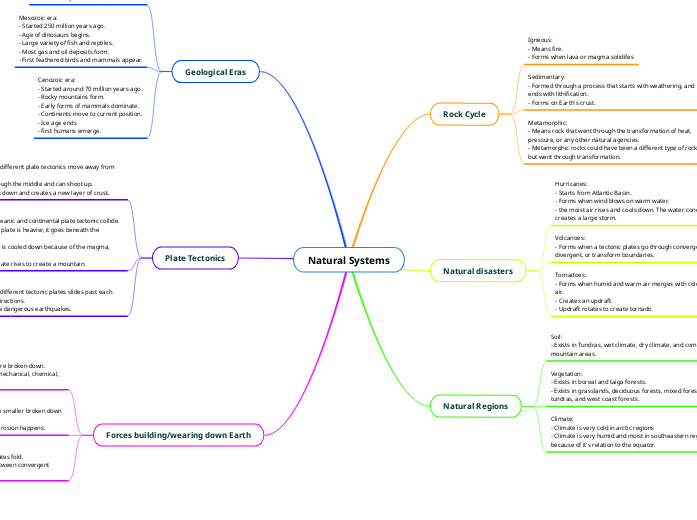Natural Systems
Rock Cycle
Igneous:
- Means fire.
- Forms when lava or magma solidifes
Sedimentary:
- Formed through a process that starts with weathering, and ends with lithification.
- Forms on Earth's crust.
Metamorphic:
- Means rock that went through the transformation of heat, pressure, or any other natural agencies.
- Metamorphic rocks could have been a different type of rock, but went through transformation.
Natural disasters
Hurricanes:
- Starts from Atlantic Basin.
- Forms when wind blows on warm water.
- the moist air rises and cools down. The water condenses and creates a large storm.
Volcanoes:
- Forms when a tectonic plates go through convergent, divergent, or transform boundaries.
Tornadoes:
- Forms when humid and warm air merges with cold and dry air.
- Creates an updraft.
- Updraft rotates to create tornado
Natural Regions
Soil:
- Exists in Tundras, wet climate, dry climate, and complex mountain areas.
Vegetation:
- Exists in boreal and taiga forests.
- Exists in grasslands, deciduous forests, mixed forests, tundras, and west coast forests.
Climate:
- Climate is very cold in arctic regions
- Climate is very humid and moist in southeastern regions because of it's relation to the equator.
Geological Eras
Palezoic era:
- Started 500-750 million years ago.
- First reptiles appeared; abundant fish.
- First life on land.
- Sedimentary rocks form.
Mesozoic era:
- Started 250 million years ago.
- Age of dinosaurs begins.
- Large variety of fish and reptiles.
- Most gas and oil deposits form.
- First feathered birds and mammals appear.
Cenozoic era:
- Started around 70 million years ago.
- Rocky mountains form.
- Early forms of mammals dominate.
- Continents move to current position.
- Ice age ends
- first humans emerge.
Plate Tectonics
Divergent:
- Occurs when two different plate tectonics move away from each other.
- Magma rises through the middle and can shoot up.
- The magma cools down and creates a new layer of crust.
Convergent:
- Occurs when a oceanic and continental plate tectonic collide.
- Since the oceanic plate is heavier, it goes beneath the continental plate.
- The oceanic plate is cooled down because of the magma; creates land.
- The continental plate rises to create a mountain.
Transform:
- Occurs when two different tectonic plates slides past each other in opposite directions.
- The effects can be dangerous earthquakes.
Forces building/wearing down Earth
Weathering:
- Rocks and other portions of the Earth are broken down.
- The different types of weathering are mechanical, chemical, and biological.
Erosion:
- After weathering, erosion cleans up the smaller broken down portions of the Earth.
- Climate and water are common ways erosion happens.
Folding:
- When convergent plates collide, the plates fold.
- Folding creates land that rises up in between convergent plates.
